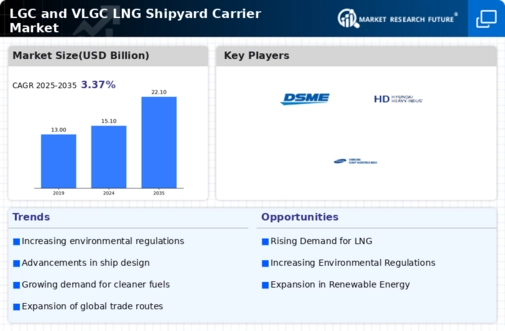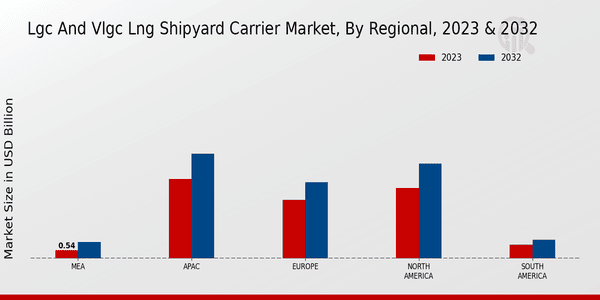Market Trends and Projections
Expansion of LNG Infrastructure
The expansion of LNG infrastructure globally is a crucial driver for the Global LGC and VLGC LNG Shipyard Carrier Market Industry. As more countries invest in LNG terminals, storage facilities, and distribution networks, the need for LNG carriers increases correspondingly. This infrastructure development is essential for ensuring the efficient transportation of liquefied natural gas from production sites to end-users. For instance, new LNG terminals in emerging markets are likely to create additional demand for carriers, thereby stimulating shipyard activities. The growth of this infrastructure is expected to contribute significantly to the market's expansion, aligning with the projected increase to 22.1 USD Billion by 2035.
Increasing Demand for Natural Gas
The Global LGC and VLGC LNG Shipyard Carrier Market Industry is witnessing a surge in demand for natural gas as a cleaner alternative to traditional fossil fuels. This shift is driven by global initiatives aimed at reducing carbon emissions and promoting sustainable energy sources. In 2024, the market is projected to reach 15.1 USD Billion, reflecting the growing preference for liquefied natural gas in various sectors, including power generation and transportation. As countries strive to meet their energy needs while adhering to environmental regulations, the demand for LNG carriers is likely to increase, thereby bolstering the shipyard industry.
Regulatory Support and Incentives
The Global LGC and VLGC LNG Shipyard Carrier Market Industry benefits from supportive regulatory frameworks and incentives aimed at promoting the use of LNG. Governments worldwide are implementing policies that encourage the adoption of cleaner fuels, which in turn stimulates demand for LNG carriers. For example, various countries offer subsidies and tax incentives for shipbuilders that invest in LNG technology. This regulatory support not only fosters innovation but also attracts investments into the shipyard sector. As a result, the market is expected to experience a compound annual growth rate of 3.49% from 2025 to 2035, reflecting the positive impact of these initiatives.
Market Diversification and Global Trade
The Global LGC and VLGC LNG Shipyard Carrier Market Industry is also influenced by the diversification of markets and the expansion of global trade. As countries seek to secure energy supplies, they are increasingly turning to LNG imports, which necessitates a robust fleet of LNG carriers. This trend is particularly evident in regions with limited domestic energy resources. The growing interdependence of global economies further drives the demand for LNG, as nations look to establish energy security through international trade. Consequently, this diversification is likely to enhance the shipyard industry, supporting the projected growth trajectory of the market.
Technological Advancements in Ship Design
Technological innovations play a pivotal role in shaping the Global LGC and VLGC LNG Shipyard Carrier Market Industry. Recent advancements in ship design and construction techniques have led to the development of more efficient and environmentally friendly LNG carriers. These innovations not only enhance the operational efficiency of vessels but also reduce their environmental footprint. For instance, the integration of advanced propulsion systems and hull designs can lead to significant fuel savings. As the industry evolves, shipyards that adopt these technologies are likely to gain a competitive edge, positioning themselves favorably in a market projected to grow to 22.1 USD Billion by 2035.














